One of the key tenets of classic style is to always dress appropriately for the occasion, which is most often stipulated by the required level of formality. But which articles of clothing are appropriate to different levels of formality, and how do they rank in comparison to one another?
For an event hosted by Queen Elizabeth II, you’d select different items than you would for office work or for a weekend brunch with friends. In this article, we present some general principles to determine the formality of nearly any menswear item and provide you with a list of clues to recognize where they fall on the scale of casual to formal.
The General Rules of Formality
Every item of clothing and every accessory falls somewhere on the continuum of formality, and there are some broader principles you can use to see at a glance where that is.

1. Casual vs. Formal Colors
As a rule, brighter colors are more casual than somber ones. A mid-blue suit, for example, is less formal than one in navy blue or charcoal gray.
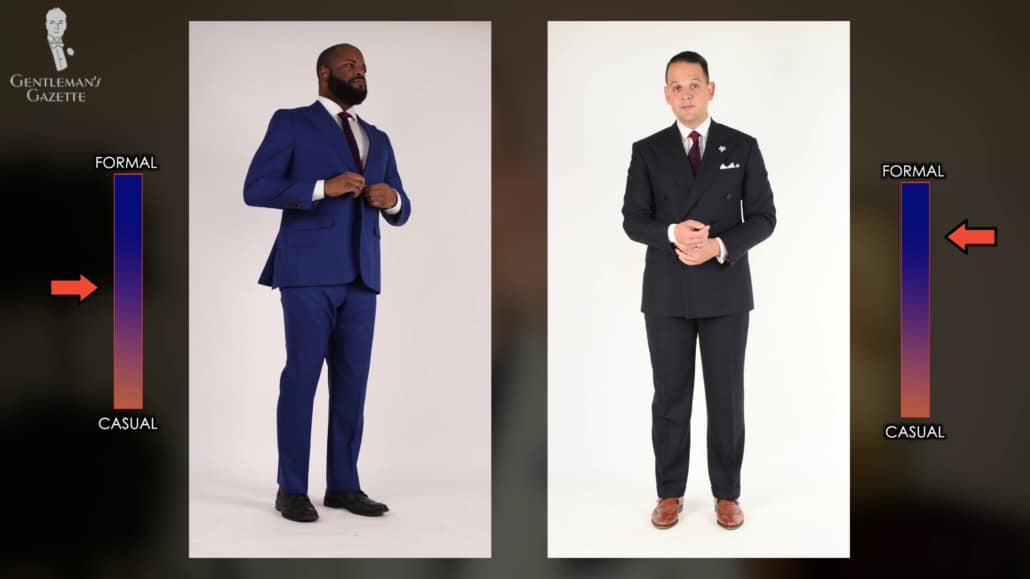
A useful technique to sort this out is to think of colors one could typically wear in the summer as casual, no matter what the season–beige, white, or light blue, for example. Although not really a bright color, brown is also more casual than navy or grey. A lot of this is owed to the long-established British distinction between city and country wear. Browns were not supposed to be worn in town, which immediately associates the color with a more casual rural setting than the charcoal grey or navy one would wear when doing business in London.

2. Casual vs. Formal Texture
The smoother and often the shinier the fabric, the more formal it generally is. A textured basketweave fabric would be more likely to appear on a sports coat than a classic suit, and corduroy would make for casual trousers, not dress pants. As a general guideline, if there’s strong visual evidence of the weave or texture, it’s more casual.
Ties that are made of rough wool or slubbed shantung are casual, while smoothly printed silks are business ties. On the other hand, you wouldn’t wear a shiny satin silk tie to work as its shine makes it too formal for that setting; satins should be reserved for evening events. Shine can be thought of as a variant on texture, as it is usually associated with smoothness. Shiny silk appears on the lapels of tuxedo jackets and on cummerbunds. Velvet, which has a distinctive sheen, is used for dinner jackets. Patent leather is used for opera pumps as part of formal evening wear.
3. Patterns and Formality
Similarly to texture, patterns also play a role in assessing formality. Articles of clothing with patterns tend to be less formal than those that are plain. Indeed, in British tailoring, many of the most popular and classic menswear patterns, particularly any plaid–from houndstooth to glen check, to Prince of Wales–were originally reserved for less formal country wear. A possible exception could be ties and pocket squares, as all sorts of patterns are acceptable on silk business ties (the printed silk it’s made of supersedes any informality of pattern).

Even formal morning wear allows ties with patterns on them, whether geometric or stripes; however, a solid color tie would still be considered more conservative. Among patterns, those that are smaller and therefore less forceful are more formal than those that are large or loud. A mistake commonly made by beginners looking to “dress up” is buying designer or fashion items that usually have a lot of ornamentation, for instance, a gold and black jacket, when the exact opposite–a lack of pattern–would actually be more refined.
4. Structure and Formality
Another rule in classic menswear is that the more something is structured the more formal it is. In the realm of suit jackets and sports coats, those with canvas, lining, and padding have greater formality than those that are unlined or partially lined with unpadded shoulders.

Ties that contain an interlining are likewise more formal than those that are hand-rolled, unlined, and untipped because the former are more constructed. Even shirts fit under this umbrella. If you have a hard collar, the shirt will be more formal than one with a soft or unfused version.

5. Purpose and Formality
Knowing the origins and historic uses of the article of clothing, which you can learn from The Gentleman’s Gazette, can also be a way of judging it. If you have something that was originally intended to be worn in the country, for sport, or for utilitarian purposes, like a flat cap or a polo shirt, it would more casual than something intended as business attire.

Now, having provided the clues that enable you to assess the formality of clothing in general, we can turn our attention to the earmarks of specific wardrobe items.
Jackets
1. Structure
Continuing the discussion above, when dealing with suit jackets or sports coats, quite simply, more structure means a greater degree of formality. It is therefore not surprising that men who are accustomed to wearing highly structured suits every day for work turn to unstructured jackets in the Neapolitan style when they’re not on the job precisely because they are more relaxed.
This is owed to the tailoring of Naples, which tends toward less structure; their jackets are lightly lined and have a “natural shoulder” free of padding. The absence of structure has led them to be embraced by those who want to dress for fun and style rather than for business pursuits.
2. Fabric
The broader rules about materials and patterns also apply, with coarse or patterned jackets tending toward the casual end of the spectrum contrasted with smooth, solid ones. We can easily rank the most common materials used for tailored jackets in order of casualness based on their general “roughness”: linen, then cotton, then wool–with raw or rough wools (tweed and flannel) being a rung below worsted, and, lastly, cashmere.

Wrinkling, common with linen (and cotton) can be thought of as a kind of texture, something that disrupts a smooth appearance, whereas wools do not wrinkle as easily, especially worsted, which elevates their formality. Cashmere has a smooth hand and a distinctive sheen that puts it at the high end. Pure silk could be thought of as the most formal of jacket materials, given its smoothness and shine, but these are nearly impossible to find and impractical to maintain because of the delicacy of silk fibers.
3. Pockets
Unique among menswear items, pocket style on a jacket serves as a strong indicator of how casual or formal it is. Patch pockets, which are formed from material sewn onto the surface of the jacket’s lower front quarters, are the most casual; they are common on sports coats and casual suits. If there is a patch breast pocket as well, the jacket becomes even more relaxed.

Next up are flap pockets. Usually, with flap pockets, no additional material is used on the surface of the jacket; the pockets are hidden beneath the surface of the jacket with only the flap visible. Flap pockets were originally associated with country wear in British tailoring but are now most common on business suits, though they may also feature in sports coats.
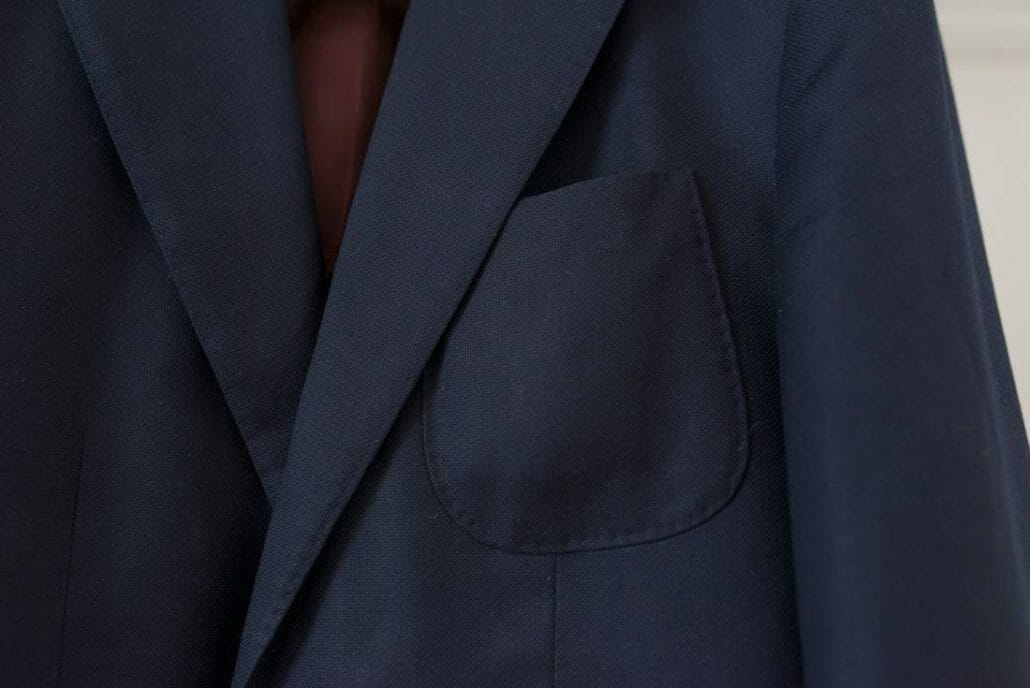
Lastly, we have jetted pockets, which are like flap pockets in construction but with no flap; the pocket is simply a slit with edge stitching. The result is a very clean, minimalist look, which you’ll find on formal wear: dinner jackets, tuxedos and morning wear.
4. Lapels
Lastly, lapels are an easy way to assess a jacket’s formality.
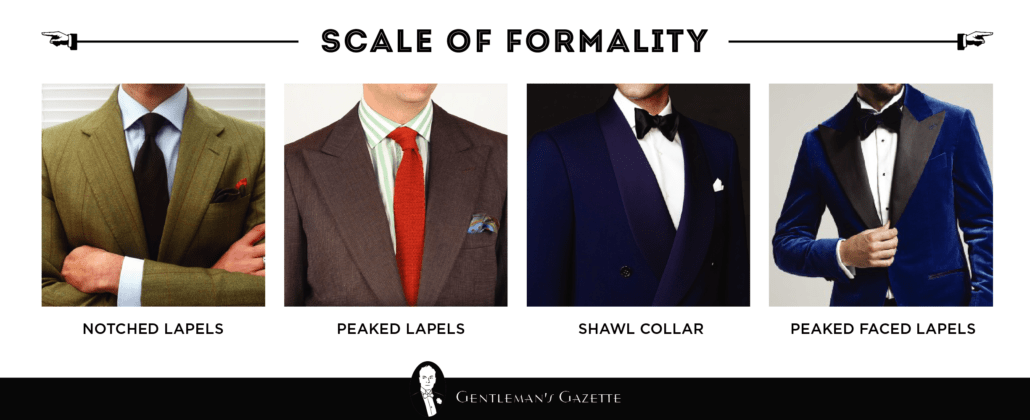
In a nutshell, a notched lapel is less formal than a peaked lapel, which is the most formal kind, appearing on power suits and formal wear. On a tuxedo or dinner jacket, you may also see a shawl collar; this is limited to formal jackets, so it remains more elevated than a notch lapel but is still more relaxed than a peak lapel. Thus, for example, a white dinner jacket that would be worn on a summer cruise should technically have a shawl collar given the relatively relaxed nature of the garment compared to a black tuxedo.

Pants
As a visual cue to assess formality, if a pair of pants has a sharp crease down the center of the legs, it’s more formal than one with a smooth front. The former are “dress pants,” while the latter would also include chinos and jeans. The “crease” division not coincidentally conforms to the rule of materials as well because dress pants are mostly made of wool while chinos are made from cotton or linen. Frankly, wool holds a crease much better than cotton or linen.

Within the category of chinos itself, there can be a range of formality as well: more casual chinos display a visible flat seam on the inner legs whereas so-called “dress chinos” are cleaner, with seams that are minimized. The presence of ornamental details on pockets, like metal rivets or decorative stitching, such as what you’d see on a pair of jeans, are also emblems of casual style.
Shirts
1. Fabric
What looks at first glance like the same plain white dress shirt can offer varying levels of formality depending on factors like the weave, the cuffs, and the collar. With its relative thickness, somewhat rough texture, and patch pocket, the Oxford cloth typical of the classic OCBD shirt is considered among the more casual dress shirting fabrics. For this reason, they add a casual touch to tailoring and may be more associated with sports coats than business suits, though the rule is flexible.

Common pinpoint cotton or broadcloth represent a middle ground in business shirts: they can be worn with essentially anything as well but are more formal than OCBDs. Even more elevated are weaves that continue the association of shininess and formality, like Royal Oxford and twills; these are best worn with suits or formal wear. Of course, following the established general principles, patterned shirts are more casual than solids, and the bigger or more visible the pattern (think wide butcher stripes or plaids) the more casual the shirt will be.

2. Collars
Dress shirt collars come in a variety of forms, and, once more, the button-down collar is the most casual, perhaps because of its association with the OCBD, or with the sport of polo, or because it shows visible buttons.

After this, the point, semi-spread, and spread are about equal in terms of formality, and all are appropriate for business settings. They can’t really be ordered in terms of formality, though arguably, because variants of the spread collar are de rigueur with tuxedos, it may be somewhat more elevated. Collars with vintage appeal, such as a tab collar, hearken back to a more formal time and are consequently seen as more formal especially when worn with a tie pin. The wing collar may be the most formal of all, as it is only worn with formal wear and has associations with vintage style.

3. Cuffs
This is an easy one since, unlike collars, there are only a few kinds of shirt cuffs. Basically, a standard button (or “barrel”) cuff is least formal, followed by French or double cuffs that require cufflinks, appropriate for more formal business shirts, black tie, and morning dress. Single cuffs with links, the most formal style, are reserved for white tie.

Ties
Where wool reigns supreme as the formal fabric for tailored jackets and dress pants, silk is the queen of tie fabrics. However, not all silks are equally formal. Ties made of raw (shantung) or wild (tussah) silk that shows a lot of texture or slubbiness and those that are knitted (as opposed to woven) silk are perfect to wear with casual tailoring. An interesting exception is grenadine, which is a popular choice for business wear even though the weave is quite an obvious feature. Perhaps this is owed to its shininess.
Ties made of materials other than silk, such as linen, cotton, wool, and even cashmere, remain less formal, either because they are not as smooth or shiny. Interestingly, pattern matters less with ties in determining formality–a printed silk tie with stripes or a repeating geometric pattern is only barely less formal than one in a solid color.
Shoes

In order from least formal to most formal dress shoes (excluding boots), we have loafers, derbies, monk straps, and oxfords. The very name “loafer” implies casual relaxation as does its slipper-like form. Derby shoes were originally country wear though they are at home with sport coats and even suits these days; still their association with casual settings remains. Monk straps are sort of at the same formality levels as derbies, but they are perhaps more frequently worn with suits than a derby would be.
Lastly, we have oxfords, which are the most formal of shoes, equally useful for suits and formal wear. Color also matters, with black shoes considered more elevated than brown, again based on the old British “no brown in town” rule. Indeed, even now many men will only wear black shoes with navy or gray business suits though brown is worn for everything in Italy and has become more acceptable with suits in most settings. The principles of shine and texture also apply, with suede and nubuck shoes being more laid back than polished calf leather. Beyond these principles, two factors–ornamentation and structure–are also influential when determining the formality of shoes.
1. Ornamentation
With shoes, less is more (formal, that is), in terms of broguing and other ornamental details like wingtips. Case in point: the black patent oxfords worn with evening attire are actually quite plain except for their high shine, and for everyday business wear, black oxfords with a plain cap toe are appropriate. In fact, these black oxfords are also the shoe to wear with a formal morning suit. However, those who are new to classic style may be drawn to the intricate perforations that form the broguing on a shoe. They assume because broguing is so ornate and requires extra leatherwork that more of it equals a fancier shoe. On the contrary, simple is more elegant, something we can remember when we keep in mind that brogue perforations were originally designed for drainage on country shoes.

2. Structure
Although all loafers can be called mocassini in Italian, even these can be sub-divided in terms of how much structure they have. A soft loafer is generally made of suede and is quite slipper-like, looking more like what one would consider a true moccasin. It’s an excellent shoe for summer weather as it is very lightweight and comfortable, which also makes it casual. Structured loafers can come in either suede or calf leather but are firmer and by virtue of this, more formal in appearance.

Conclusion
Knowing whether an item from your wardrobe is casual or formal, and to exactly what degree, can be important. It can help you decide whether what you are wearing is formal enough for an occasion or whether it’s too formal for everyday situations. It can also help you coordinate and pair aspects of what you wear because you’ll know, for example, that oxford shoes don’t usually work with jeans unless you’re trying to make a statement with the incongruity. Fortunately, there are certain qualities and earmarks that help you sort out where items reside on the scale of formality and thus which ones go together.
Do you have a different system for distinguishing smart casual from formal clothes? Are there other articles of clothing that can be sorted by levels of formality? Let us know in the comments below.
Outfit Rundown
My jacket is made out of a linen fabric in a classic Prince of Wales pattern that has elements of turquoise, green, blue, and grey which is very summery, it also has a lot of texture, then it features peak lapels which were traditionally more formal but it has informal patch pockets and informal white buttons. It has a bit of structure and some lining in the sleeves but the back is unlined.
I’m combining it with a shirt made of a more casual denim fabric but as barrel cuffs makes it a little casual but a collar that could be also worn with a three-piece suit if the shirt was white. I did skip the neckwear all together which makes it more casual but I’m wearing a silk pocket square which makes it more formal and a boutonniere which adds a touch of color and is definitely more stylish detail that earns you compliments, guaranteed. You can find both of them in our Fort Belvedere shop.
My pants are a classic pair of cotton chinos and the crease has come out and you see a bit of wrinkling, so it works well with my jacket. My shoes are a pair of Darby shoes in dark brown to provide enough contrast so they’re visually interesting but I make them a bit more casual by adding a contrasting pair of shoelaces. Shoelaces are a great way to change the look and the formality of your shoes simply by changing a small detail that is very inexpensive.
The socks I’m wearing are shadow striped socks from Fort Belvedere which is over the calf in light gray and blue which picks up the color of my jacket but brought enough contrast between the shoes and my pants to make them all work together. My pinky ring in white gold with a star sapphire picks up the lighter color scheme of the outfit and my belt from Fort Belvedere picks up that silver tone from the ring and combines it with the color of the shoes in a dark chocolate brown. It’s part of a belt system that allows you to combine any belt with any buckle but it looks like a proper belt every time.





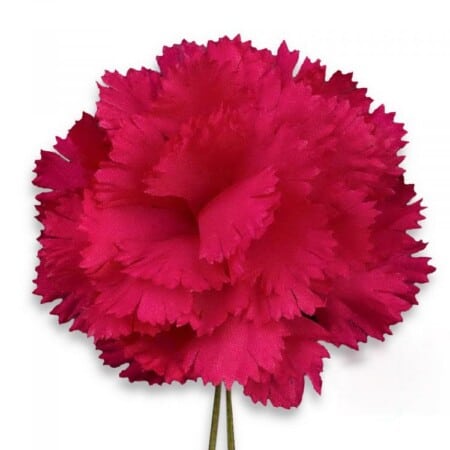






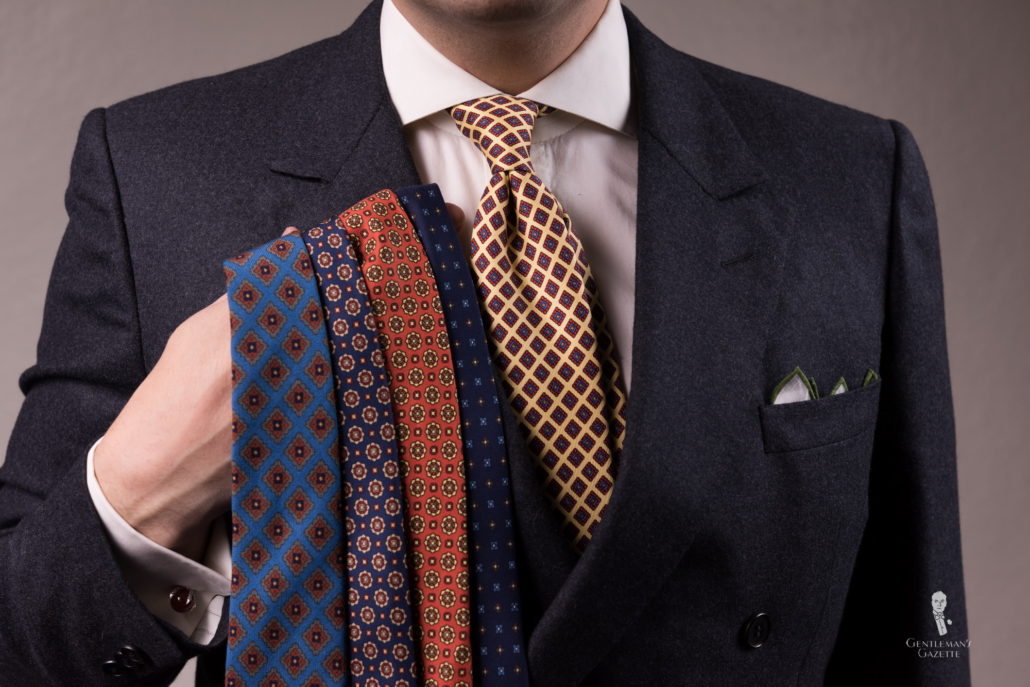
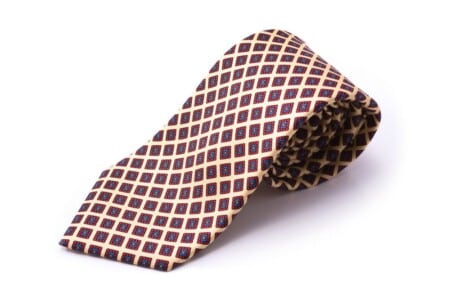



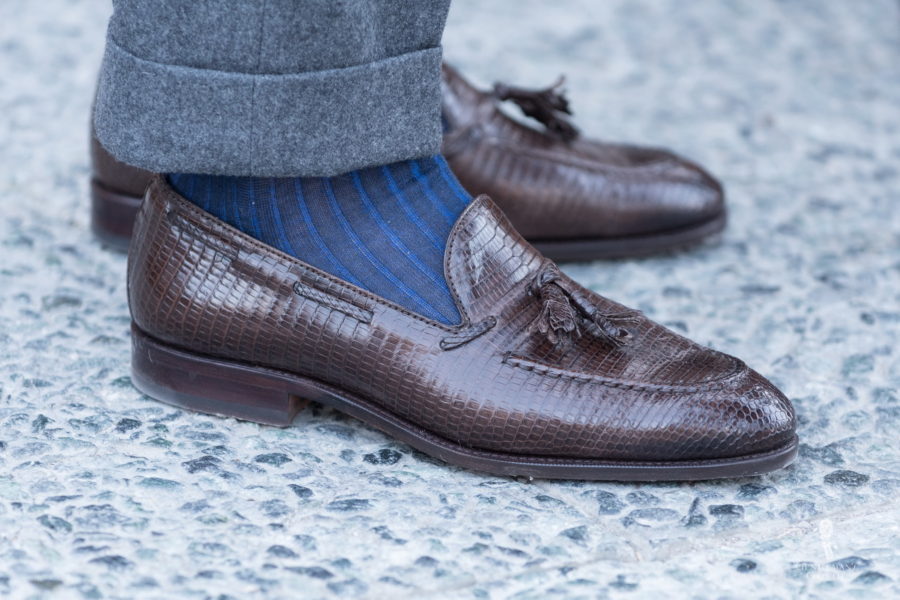






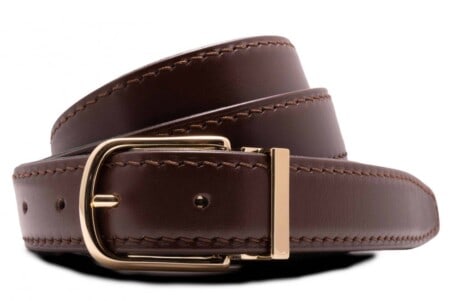

My dear sir, I see that the lovely young Meghan and her in-laws-to-be have appealed to Mr.Schneider on more than one occasion and trust that he has learnt from his mistake and will pay more attention to them than he has to me. I suspect that the dancing after dinner on Saturday will be a total washout because the ladies will be dancing with each other while we men twiddle our thumbs at the side of the floor waiting for the conga or something fairly easy like that, and all because he rejected my advice to instruct us in the art of the waltz.
Hello, is that you, Brigadier? And the waltz would have been so appropriate:
Slough, Slough, Quick, Quick, Slough!
Superb article. Clear and practical. Thank you.
Thank you!
Hi Christopher,
thanks for the guide, really well written. What do you think about the formality degree of Mexican huaraces? I would say that a pair of open-toe huaraces is just a little more formal than a pair of regular leather sandals. When it comes to closed-toe huaraces, I would say that they are a step above espadrilles in terms of formality, but still below boat shoes.
Oddly enough, a friend of mine who lives in Italy is invited to a first communion ceremony and party in the weekend, and he was planning to wear a sport coat with white pants and a pair of closed-toe huaraces (sic!). He asked me for an advice and I told him that it would be a faux pas: nowadays in Italy this kind of ceremonies are not as formal as they used to be, but quite few people still wear a suit with dress shoes. In any case, it seems to me that a pair of huaraces would be totally inappropriate and that generally huaraces are hard to pull off with a sport coat combination.
What are your thoughts about this?
Thanks
Hi, Matteo. I would agree with your assessment of huaraches. Open-toed shoes or sandals are to be avoided with any sort of tailoring and would do best on the beach. Regarding closed-toed ones, I would say a shirt and trousers only for those. I can’t see them with a sport coat.
I actually arrange all of my clothes and shoes in my wardrobe by degree of formality. I find it truly helps with picking an outfit.
Thanks for sharing!
Quick question. Which would you say is more formal? A suit without a tie, or a blazer, tie and chinos of the more formal variety (tailored, double breasted, brass buttons, and tailored chinos?). Thanks!
If I were to take the liberty to answer, it would really depend on the occasion… But I would say the latter. Here’s my reasoning.
If you go to an event wearing suit, no tie and everyone else is wearing suit + tie, you would stick out (in a bad way). If you go to same event dressed in blazer, tie, chino, etc. as you point out you would stick out perhaps only a little bit – but in a good way.
Interesting query, Tarquin. My intuitive response is that the uniformity of a suit always makes it more formal than a split of blazer with different colored trousers. If the chinos are cotton, the answer is even more certain. With wool, it may come close, but tie or not, I’d say a suit is more formal.
Brilliant article, simple without losing the essence of the subject. Should be a great confidence builder to novices in these matters,
Thank you
Top article. The “Scale of Formality” graphics are a brilliant.
GG does this stuff so well.
Thank you!
What do you think of shirt-fronts?
Personally, I find that those that have a smooth fisnish appear to be more elegant and fomal than those of more complicated finish.
Of course, I do not dignify of my consideration ruffled shirts that should be confined to the attire of Luna Park Magicians.
Gerofono, I would agree that the principle of smooth and plain = more formal fits with shirt finishes too.
Impressive article, so useful.
I learn a lot from these types of articles. Go on!
Great article, thank you!
I would like to share about monk. As you said they are considered as more casual type of shoes. And I’ve bough my pair keeping this in mind.
However with navy chinos they are really bad. Even my plain brown oxfords are better.
But with navy dress pants they are perfect. I don’t know why. Maybe because of material (cordovan) maybe because of the shape.
Simply splendid.
Hey, Thanks for the review! There’s only one problem that I see with the double breasted models shown (the /ford tux and the Blue tux with faced lapels). Both of those suits look like. they have very wide lapels (wide enough to land a plane on!). I’m certainly hoping such is not the case as they look rather tacky (but that’s just one man’s humble opinion). I used to own a DB tux, but found SB to be more along my silhouette’s line much better. It must be true as I’m always receiving compliments about my tuxedos when I wear them (and these aren’t any rent-a-tux rejects either, but bespoke models) Still, for those who can pull off a DB suit, I don’t think they’d want to be wearing “airport” runway style lapels at any time. Most o that went out in the 80’s (and that was when even sB suits looked like they had wide lapels too).
I have two questions:
1. Pleats on trousers? Do these make them less formal since they add some texture and break up the smoothness of the front of trousers? Or are they more like creases and add to the formality? Or do they just not matter?
2. Which style of shoe do you think is most versatile in terms of being able to span smart casual through to business attire? A derby perhaps?
Chancellor, my sense is that both pleated and flat front can be equal in formality, though high-waisted pleated trousers are worn a lot these days as kind of a relaxed summer look. Regarding shoes, a derby can be worn casually and, certainly, with a sport coat and trousers. I think a double monk can do the same, as it can be worn with jeans and even with a suit, though the monk would be more aggressive and less traditional a look.
What is your take on the Guayabera shirt?
Hi Christopher ! Thanks for this nice and informative article, which goes straight to the point.
Strangely, for the jacket lapels, I ‘ve heard both version, that notched lapels are more formal than peak, and vice-versa. Peak lapels being less common, I guess you don’t see them too often in jobs such as consulting or finance, so maybe they’re seen as less formal because they’re a stylistic touch.
Anyway, I have a question about pants. Does the rise of the pant affect formality in your opinion ? Same goes for pleats (no pleat, single double, inside vs outside pleats, etc.) ?
Good questions, Christopher. I personally haven’t worn pleats in a long time though I plan on trying a pair to see how they work with my build, so I’m not certain about the formality attached to the number or direction of the pleats. My gut says there’s no difference, however. Regarding rise, I suppose high rise can be more formal since it has a traditional affiliation with classic menswear and, especially, three-piece suits. The high rise was meant to be high enough to cover the gap of a white shirt and prevent it from peeking out under the waistcoat or vest.
Wonderful and very useful information. The level of formality required for specific events in today’s business world is often difficult to judge before you actually enter into the lion’s den. What I often tell our clients is to use a layered approach to dressing for an occassion. Start with the most formal outfit you believe is appropriate for the event. If you think a suit is the way to go, you can always remove the tie to dress down a bit. If you’ve dressed more casually and you are wearing a sport coat and pant, you can remove the sport coat for a more casual effect. So the idea is to dress up and be in a position to remove an item that creates a more formal look. Always consider, you want to fit in but you also want your clothing to reflect your image.
Leo Green
Thanks for sharing, Leo!
Great stuff — is there a way to download in pdf?
Hi there! This is not downloadable in pdf but you can always save this page to your bookmarks for easier access :)
It started off as an interesting article but this new layout killed it! I’m using Firefox on a Mac (latest versions of Firefox and OS/X) and the right hand side bar overlays a lot of the text (probably – at a guess 10-15 letters) and pictures making the article unreadable.
Shame because I enjoy reading a lot of your articles and this really did look like an interesting one but I just had to give up as so much of the end of sentences was overlaid it just made it too difficult to read.
Sorry to hear that. Have you tried using a different browser?
I’ve always considered brown shoes of any sort to be inappropriate with formal suiting. However, at a suit-and-tie wedding last year, I noticed most men in this younger crowd were wearing different shades of brown shoes with their blue and dark grey suits. Actually looked OK – fashion and style do indeed evolve and change with the times.
Thanks for sharing your thoughts!
I used to pick brown shoes always and I like black color in blazers.
Thanks for sharing, Shira!
Can you please direct me to an appropriate article? Due to medical reason I am unable to work. However, I would still love to dress in the gentlemanly style, especially when I am out with my family.
Hi James,
We have a plethora of guides. Do you have any specific event in mind?